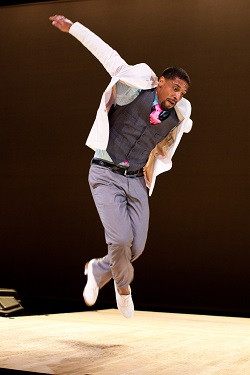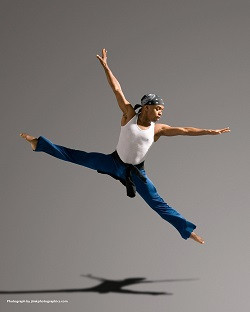Dance has taken center stage on television, becoming a primetime staple with a plethora of reality shows, competitions, and awards shows dedicated to the art form. This surge in visibility offers undeniable advantages, yet it also raises critical questions about the impact of such mainstream, often Hollywood-ized, platforms on dance itself. For those immersed in the dance world, a crucial debate emerges: do the benefits of Dance On Tv Shows outweigh the potential drawbacks for the art form?
Jason Samuels Smith, a renowned tap dancer, choreographer, and director, firmly believes in the positive influence of television for dance. Having contributed his talents to popular shows like Fox’s So You Think You Can Dance and ABC’s Dancing with the Stars, Smith emphasizes the unparalleled reach of television. “The exposure is the key component,” he states, “Without these mediums, we wouldn’t connect with nearly as many people.” He plans to continue his work in television, recognizing its power to broaden dance’s audience.
Jimmy Locust, a highly respected choreographer and dancer with an impressive resume including performances with iconic artists like Paula Abdul, Janet Jackson, and Michael Jackson, shares Smith’s view on television’s potential to expand dance’s reach. However, Locust also voices concerns about the typical portrayal of dance on TV.
 Jason Samuels Smith tap dancing solo.
Jason Samuels Smith tap dancing solo.
“Earlier in my career,” Locust reflects, “dance was held in high regard, presented with great care and respect.” He expresses disappointment in observing contemporary dance reality shows that often amplify negativity and employ questionable motivational tactics towards young dancers. Locust points out a sense of “belittlement to the dancer” in some programs. He understands the driving force behind this approach is ratings, as drama tends to captivate television audiences, ensuring viewership week after week. However, Locust worries that this frequently scripted drama can overshadow the true essence and artistry of dance.
This very concern motivated Locust to create his own web series, Locust Under 5. This online show offers viewers an inside look into classrooms at the Locust Performing Arts Center, aiming to convey a positive message about dance’s ability to empower young individuals and foster personal growth. He seeks to use the camera to highlight the nurturing and developmental aspects of dance education, contrasting with the drama-centric narratives often seen on mainstream television.
Another significant issue that arises with dance on TV shows is the pervasive culture of fame. In the reality TV era, instant stardom seems attainable for anyone. Many contestants from dance competition series emerge with fame as their primary goal, sometimes overshadowing their dedication to dance itself. “The television industry can take the dance bug out of them,” suggests Locust, implying that the pursuit of celebrity can dilute the artistic passion. However, Smith offers a different perspective, arguing that television is not the root cause of shifting artistic priorities. He believes true artists will remain committed to their craft, while those primarily seeking fame will exploit any available platform to achieve it, regardless of television’s influence.
Smith also acknowledges a critical gap: increased TV exposure doesn’t automatically translate into larger audiences for live dance performances. He notes that while these shows raise awareness about dance, they don’t necessarily motivate viewers to attend live dance events. Therefore, Smith urges dance professionals to proactively promote and cross-promote live performances to diverse audiences, bridging the gap between television viewership and live audience engagement.
 Jimmy Locust, renowned dancer and choreographer, in a thoughtful pose.
Jimmy Locust, renowned dancer and choreographer, in a thoughtful pose.
The Los Angeles Ballet provides an interesting case study in leveraging television’s growing interest in dance. In 2012, artistic directors Thordal Christensen and Colleen Neary collaborated with Sonya Tayeh and Stacey Tookey, both popular choreographers from So You Think You Can Dance, for their NextWave LA series. By commissioning works from choreographers with strong TV followings, the LA Ballet sought to attract a broader audience. While reviews from the Los Angeles Times were mixed, this initiative highlights an effort to capitalize on television-generated interest, particularly within the commercially influenced dance scene of Los Angeles.
Despite the criticisms, the surge of dance on primetime and cable networks has undeniably fueled positive developments. Dance studio enrollment has increased, and more boys are participating in dance. Furthermore, these shows have created numerous opportunities for emerging dancers, jumpstarting many young careers. “Overall, it’s a positive springboard for the dance community,” concludes Locust, acknowledging the beneficial ripple effects.
Looking ahead, Smith anticipates a greater diversity of dance programming on television, showcasing the talents of both amateur and professional dancers across various genres. He expresses hope for increased representation of tap dance and other underrepresented styles, believing it would enrich the content and broaden audience appeal. He also advocates for “more homegrown grassroots programming that truly reflects current and classic dance styles impacting today’s dance world,” emphasizing the need for authenticity and deeper artistic exploration.
In conclusion, the question of whether dance on TV shows ultimately helps or hinders the art form is complex and nuanced. The undeniable popularity of such programming necessitates a critical yet constructive approach from dance artists. While drama may be inherent to engaging television, dancers, directors, and choreographers must consciously consider their objectives when bringing dance to the screen. The central question remains: is the goal primarily to create compelling TV entertainment, or to cultivate and elevate dance as a valuable art form? This ongoing dialogue will shape the future trajectory of dance on television and its lasting impact on the dance world.

